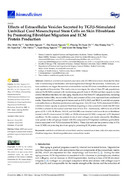Effects of Extracellular Vesicles Secreted by TGFβ-Stimulated Umbilical Cord Mesenchymal Stem Cells on Skin Fibroblasts by Promoting Fibroblast Migration and ECM Protein Production

Xem/
Năm xuất bản
2022-07-27Tác giả
Vu, Duc Minh
Nguyen, Van Tinh
Nguyen, Thu Huyen
Do, Thi Xuan Phuong
Dao, Huy Hoang
Do, Xuan Hai
Le, Nhi Thi
Nguyen, Xuan Hung
Tran, Thi Trang Uyen
Metadata
Hiển thị đầy đủ biểu ghiTóm tắt
Umbilical cord-derived mesenchymal stem cells (UCMSCs) have been illustrated for their roles in immunological modulation and tissue regeneration through the secretome. Additionally, culture conditions can trigger the secretion of extracellular vesicles (EVs) into extracellular environments with significant bioactivities. This study aims to investigate the roles of three EV sub-populations released by UCMSCs primed with transforming growth factor β (TGFβ) and their capacity to alter dermal fibroblast functions for skin aging. Results show that three EV sub-populations, including apoptotic bodies (ABs), microvesicles (MVs), and exosomes (EXs), were separated from conditioned media. These three EVs carried growth factors, such as FGF-2, HGF, and VEGF-A, and did not express noticeable effects on fibroblast proliferation and migration. Only EX from TGFβ-stimulated UCMSCs exhibited a better capacity to promote fibroblasts migrating to close scratched wounds than EX from UCMSCs cultured in the normal condition from 24 h to 52 h. Additionally, mRNA levels of ECM genes (COL I, COL III, Elastin, HAS II, and HAS III) were detected with lower levels in fibroblasts treated with EVs from normal UCMSCs or TGFβ-stimulated UCMSCs compared to EV-depleted condition. On the contrary, the protein levels of total collagen and elastin released by fibroblasts were greater in the cell groups treated with EVs compared to EV-depleted conditions; particularly elastin associated with TGFβ-stimulated UCMSCs. These data indicate the potential roles of EVs from UCMSCs in protecting skin from aging by promoting ECM protein production.
